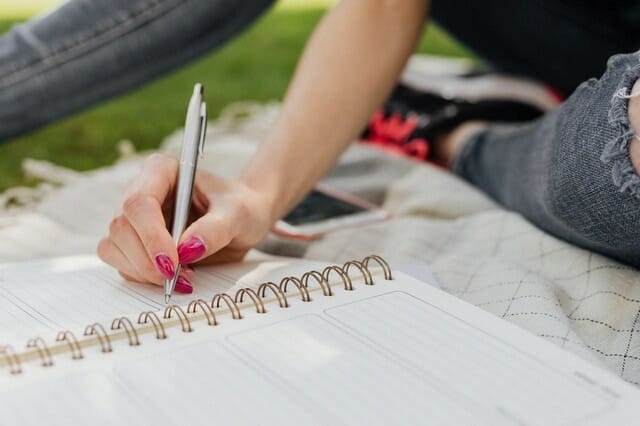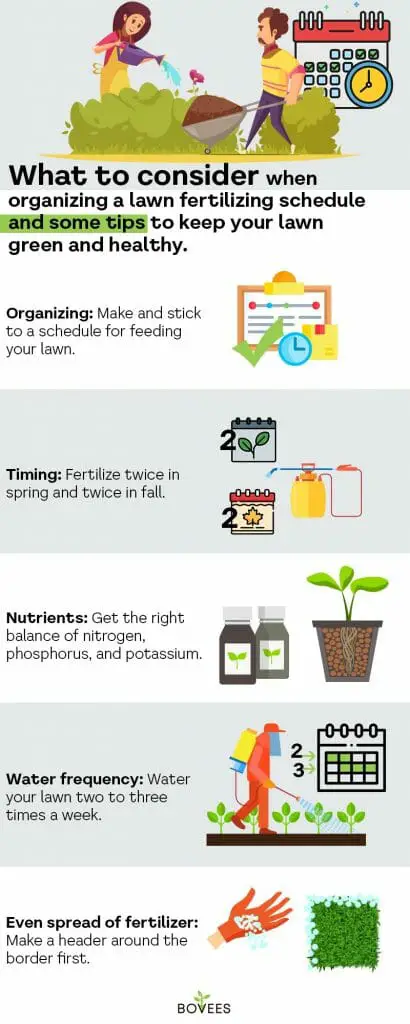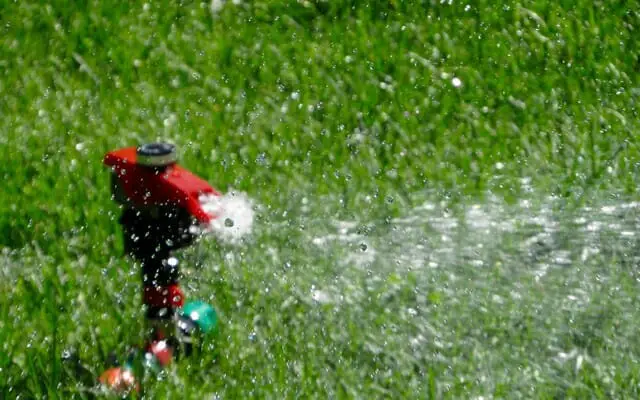Last Updated on January 16, 2023 by Grow with Bovees

If you want a green, healthy, and lush lawn 365 days a year, what you need is a lawn care and maintenance program.
The program should consist of watering, weed removal, and fertilizing, which can be done with weed and feed. Let’s take a look at the lawn fertilizer schedule, a little lawn care, and how they impact your yard.

What Is a Lawn Fertilizer Schedule?
There are several factors that you have to consider when you’re deciding on your lawn fertilizer schedule. These factors are your location, grass type, if the lawn is new or established, if there has been a problem with pest disease, and how much you use your lawn.
Fertilizing your lawn while considering these factors will be the best way to get that lush green lawn of your dreams.
The Best Time To Apply Fertilizer To Your Lawn
Not everyone agrees about when the best time to fertilize your lawn is, and there are a few factors to keep in mind. First, the weather. If there’s extreme heat in the forecast, you should feed your lawn in the afternoon.
If it’s going to be a cool day, your fertilizer schedule should include the morning.
You also need to consider how much sun is expected. A lot of direct sunlight is not good for fertilizing day. Consider delaying it until the next cloudy day.
And what about rain? With organic lawn fertilizer, such as Milorganite, your fertilizing schedule needs to include watering your lawn one or two days before your application day.
The soil needs to be wet to allow decomposition. Unless it rains a few days after application, you’re going to have to water the lawn again.
There’s also the time of year to consider. Your application rate should be four times a year if you’re using a slow releasing fertilizer.
Apply fertilizer in early spring and again in late spring. After the heat of summer, you’re free to fertilize again in early and late fall.
Buying Fertilizer: What Should You Look For?
You need to think about three main things when buying fertilizer, including weed and feed products, and all three of them appear in numbers on the outside of the bag.
These are the percentages of nitrogen (N), phosphorus (P), and potassium (K) that are in your bag of fertilizer. Getting these numbers in the correct proportion for your lawn fertilizing schedule is what will give you the lawn you want.
- Nitrogen (N): Nitrogen is by far the most important nutrient because it’s a component of chlorophyll, which is the stuff that makes your lawn look green. Look for high numbers here.
- Phosphorous (P): Phosphorous is vital for root growth and maturation. It affects the rate of grass seed development. Use high numbers of phosphorus for newly seeded lawns.
- Potassium (K): Here’s where your lawn gets its nutrients to fight off diseases. It also helps with your lawn’s ability to deal with environmental stresses like heat, cold, and drought. This number is usually fairly high but not as high as nitrogen.
When you read your fertilizer label, you will see three numbers that are always in this order: nitrogen, phosphorus, and potassium. So a 25-10-15 bag has 25 percent nitrogen, 10 percent phosphorus, and 15 percent potassium. This bag of fertilizer would be considered to be complete because it has all three of the nutrients.
If you see a zero in one of the three numbers, it means that there’s one nutrient missing. It might look like this: 20-0-15. This doesn’t mean the fertilizer is not good; it just means that it suits a lawn that doesn’t need phosphorus.
Using Slow Release Lawn Fertilizers
Slow release fertilizers are best for established lawns as they provide nutrients over a longer period. Young or new lawns often need a quick boost in early spring, and they won’t get this from a slow releasing fertilizer.
Slow release fertilizers can be either organic or artificial. Because organic varieties break down naturally by decomposing, they’re considered naturally slow releasing lawn fertilizer.
For the artificial variety, it’s a chemical that releases the nutrients slowly. A resin coating on the fertilizer breaks down slowly over time, allowing it to be considered a slow release fertilizer.

How Frequently Should You Water Your Lawn?
In times of non-extreme weather, you should be watering your lawn between two and three times a week. Keep that as your rule of thumb. Obviously, in periods of rain, you’ll decrease this and increase it in drier times.
Over-watering is harmful to both your lawn and your community. You can also end up with a muddy yard. Depending on where you live, water can become scarce in summer. If you and your neighbors are all over-watering your lawns, a water shortage may result, and restrictions will be put in place.
So how long should you leave your sprinkler on? To see how long it takes to water a half-inch of lawn, scatter some empty tin cans around your lawn, turn on your sprinkler and then start your stopwatch.
When the cans are half an inch full, the time is right to turn off the sprinkler and note the time on the stopwatch. This is the ultimate time for watering your lawn.
Don’t Forget To Read the Instructions on the Side of the Bag
There’s a lot you can learn by reading the side of your fertilizer bag. So, before you fertilize your lawn, take a look at the instructions. What’s important to keep in mind is that the advice on lawn care given there probably doesn’t consider the different weather, uses, and grass type. So, yes, read the instructions, but don’t forget to remember the things that make your lawn unique.
What About a Lawn With an Unusual Shape?
If your lawn has curved borders in an unusual shape, the best way to fertilize it is first to run your spreader around the outside rim. This is called making a header.
Once you’ve made your header, you can then start going back and forth as you would with a square or rectangular lawn.
Some Last Minute Lawn Fertilizer Tips
- Fill the spreader on a hard surface like your asphalt driveway or patio. This makes it easier to sweep up if you spill. If you have to fill the hopper while on your lawn, use a tarp under the spreader.
- Make sure the hopper is locked before pouring fertilizer into it.
- Keep your walk at a consistent speed when you fertilize your lawn.
- While the soil can be damp, the grass blades should be dry before application. This avoids burnt grass.
- Follow the instructions about keeping kids and pets off the lawn for 48 hours after fertilizing. It’s unsafe for them, especially if you’re using chemical fertilizer. Organic lawn fertilizers are generally safer, but it’s still a good idea to keep them away for a day or two.
- If there’s a stream or well nearby, you must keep a safe area of at least 20 feet (6.1 m) from them. Don’t apply any fertilizer in this safe area.
- Heavy rains will wash away your fertilizer, so keep track of the weather forecast and avoid fertilizing during these times.
- It’s a good idea to trim your lawn a couple of days before applying fertilizer.
Remember To Enjoy Your Lovely Green Lawn

After all the hard and diligent work you’ve put into your lawn, don’t forget to enjoy it. The above instructions shouldn’t make you see your lawn as a fragile expanse that has to be constantly protected.
Once you have a working water and lawn fertilizer schedule, your lawn will be healthy and strong and able to fight infections.
So get out there with the dogs and kids and enjoy your lawn. Set up the badminton net, make a croquet course, or just lie around and enjoy the lovely, soft grass you have nurtured so carefully.

